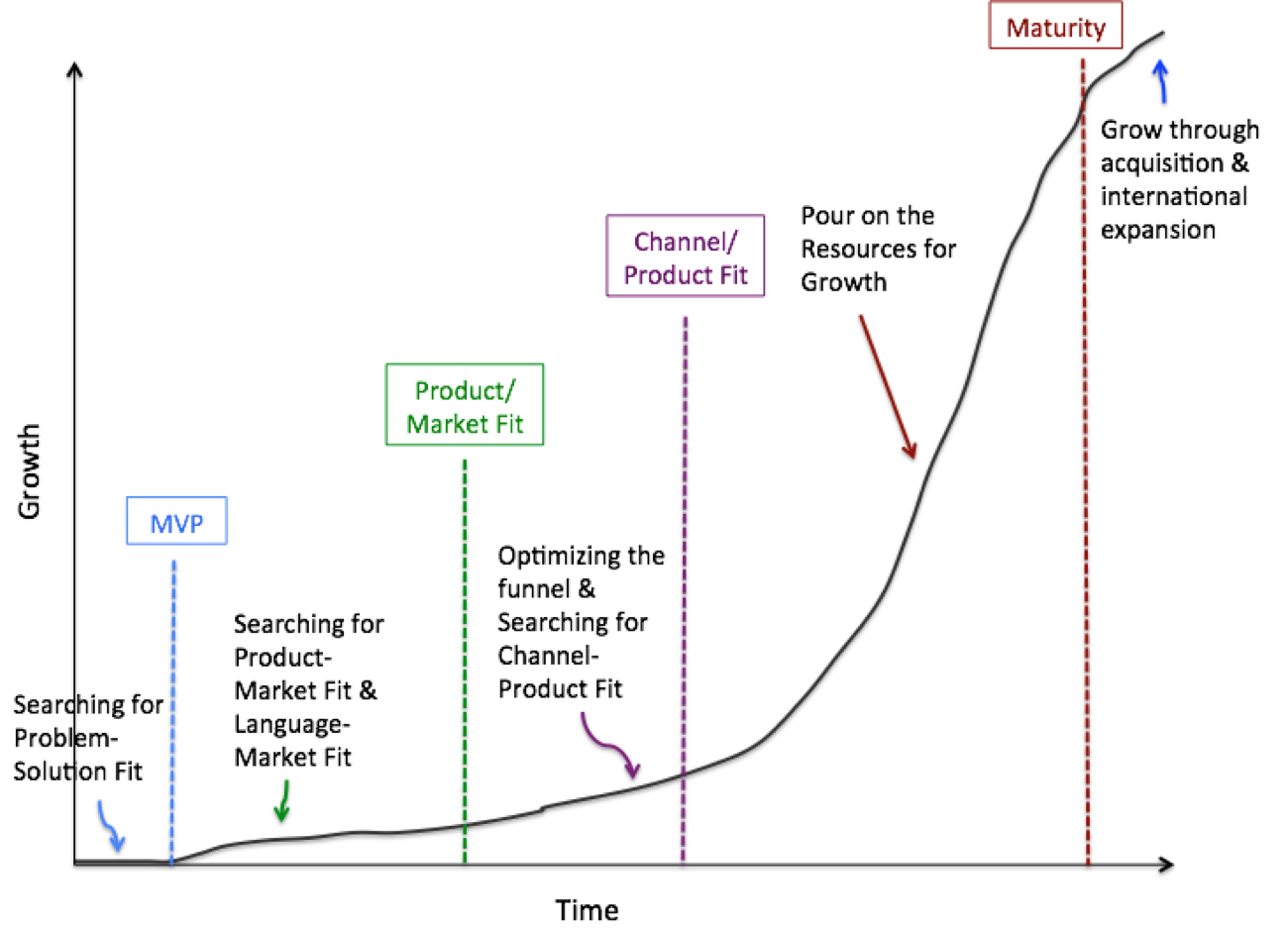In this interview, Lauren Bass dug into the question of what growth looks like at different stages in a start up’s life cycle. So put your growth marketing pants on and let me walk you through Morgan Brown’s take on the key stages, and related inflection points, in a startup’s growth trajectory.
 |
About Morgan Brown |
The best growth leaders know how to adjust their focus depending on what their startup needs at any given phase in its trajectory.
I had the chance to interview Morgan Brown, one of growth’s OG’s. He has served as the Head of Growth at Qualaroo, GrowthHackers.com, and a number of other high growth startups. I found out that Morgan isn’t only a total badass when it comes to strategizing and executing growth plans, he’s also incredibly articulate when explaining the processes and frameworks that underlie his approach.
In the interview, I dug into the question of what growth looks like at different stages in a start up’s life cycle. So put your big girl growth marketing pants on and let me walk you through Morgan’s take on the key stages, and related inflection points, in a startup’s growth trajectory.
Frameworks are Great, but They Aren’t Life
Morgan was the first to admit that a caveat was needed when talking about the “rules” for growth. Frameworks are great for teaching concepts but in the end life so often evades our best efforts to put method to madness. So, as neat and tidy as this framework looks, anyone who’s thrown their hat in the startup ring knows there are infinite variations on how the parts of this outline can be mixed, matched, layered and timed. Though you can never be sure how the details of your startup’s life story will reveal themselves, you should recognize bits and pieces of this framework all along the way.
The Stages
- Problem/Solution Fit
- Minimum Viable Product (MVP)
- Product/Market Fit
- Scale
- Maturity
 |
|
|
Phase 1) Find Problem/Solution Fit
You have an idea for a product that you just can’t get out of your head. Maybe it was even born from one of your own needs. You’re off to a good start.
At this point, ask yourself two questions: “What problem am I compelled to solve?” and “Does my proposed solution solve it effectively?” If you have a clear answer to the first question and a confident “Yes” for the second, then you’ve got problem/solution fit and a hypothesis, and it’s time to start pressure testing your idea.
Do This:
- Study the Lean Startup framework and apply it to your discovery process.
- Conduct problem/solution fit interviews like crazy.
- Have a hypothesis about who the target user may be for your product.
- Find people that fit that profile and talk to them. For inspiration, check out Episode 20, How to Get Your First 10 Customers, on Hiten Shah’s and Steli Efti’s The Startup Chat podcast.
- Ask them tons of questions to understand how they view the problem and what they are currently doing to solve it.
- Drill down into their specific pain points around the problem.
- If possible, run demand tests
- Use landing pages or even a crowdfunding campaign to test demand.
- If people are biting, you may be onto something — it’s time to invest in building a more robust product.
- Use your discoveries from interviews and demand tests to start cooking up your initial blueprint for your MVP.
- Iterate on your proposed problem and solution as new information flows in.
Phase 2) Build Your MVP
The purpose of this next step is to test your product hypothesis with the smallest possible investment of time and capital, hence, minimum viable product. In this way you are proving demand and learning about customer behavior, while minimizing risk. Once you put your MVP out into the wild, focus on getting users flowing into your product — this is where the seeds of initial startup growth are sown.
“For initial users, there isn’t a hard and fast number, but you need enough users moving through so you can see whether people are sticking around and using your product or abandoning it.” -Morgan Brown
Do This:
- Refer the Lean Startup Framework for best practices on building an MVP.
- Keep in mind that an MVP for one company may take one day to build and for another it may take 6 months. There are many different types of MVPs and you must use your judgement to decide what an MVP looks like that will adequately test your idea. Take a look at 15 Ways to Test Your Minimum Viable Product for some guidance.
- Conduct a minimal amount of channel discovery to get some initial users using your product so you can measure retention.
- Only do as much channel discovery as you need to get your initial users. You will be investing in more robust channel discovery later when you’re preparing to scale.
Phase 3) Work For Product-Market Fit
Your MVP gained traction, you’re learning and iterating, you’ve got paying customers, they buy again and keep using your product on a regular basis, maybe they’re even telling their friends about it. These are the telltale signs of product/market fit, that ever so elusive entrepreneurial carrot.
“Retention rate is your best measure of product/market fit, the higher your retention rate the more it’s a must have product.” — Morgan Brown
Take his words to heart — always measure retention rate and use it as your north star to navigate this whole startup game.
One caveat: the usual rules of searching for product market fit through limited customer acquisition and testing don’t apply if you have a network effects business or marketplace such as LinkedIn or Airbnb. For two-sided market products like these, you need to achieve some semblance of scale, with liquidity on both sides, to actually test whether your product works and people keep using it. Products in which the value can be experienced regardless of network effects, such as HubSpot or Evernote, show indications of product-market fit before scale. For this reason, for a two sided business model, you need to get to some critical mass and refine the product along the way to get to a must-have product.
Do This:
- Test for product-market fit
- Survey users to understand how they feel about your product
- Measure Net Promoter Score (NPS) — if it’s a 9 or a 10 you’re in good shape
- Use Sean Ellis’ test for product-market fit — if 40% or more of your users say they would be very disappointed if your product was taken away that is a good indicator of product-market fit.
- Measure retention rates and look for a stabilizing retention rate over time. What’s a good retention rate? Depends on model and vertical.
Morgan drilled down a bit deeper into some of the stops along the road to product/market fit, including:
- Language-market fit
- Funnel optimization
- Channel-product fit
Test for Language/Market Fit
When it comes to language/market fit, the key is to figure out how to talk to your users about what your product does so that they “get” it. This is where you test your messaging to make sure it resonates with your target customers.
Do This:
- Define your product’s positioning in the market and to your target users
- A/B test different messaging around:
- The value proposition of your product
- The tagline
- Product descriptions
- Features and benefits
- Calls to Action
Perform Funnel Optimization
“Before you turn up the dial on acquisition, make sure your user flows are solid and you bring people into your product in the most intuitive way possible.” -Morgan Brown
Funnel optimization is where you experiment with different elements of the user experience to reduce and remove points of confusion. This may involve testing landing pages, calls-to-action, the user onboarding process, and any other key actions users take as they learn how to use your product. It’s done with the intention of optimizing for activation, conversion and retention.
As I wrote about previously in Build a Growth Machine Like Andy Johns, the heart and soul of any successful funnel optimization effort is to uncover the “Aha Moment” for users and get them to it as quickly as possible. At Qualaroo, Brown’s team found that retention rate increased significantly when users received 50 or more responses to a survey. With that Aha Moment in mind, the team optimized the product to maximize survey responses during the trial period.
“Look for signals of things that make certain users more successful than others and do more of that.” — Morgan Brown
Do This:
- Segment your audience — make sure you are targeting the people who get value from your product.
- Figure out what’s unique about the users that stick around and those that churn
- Find the critical actions they take and milestones they reach that unlock the value of the product.
- Bake those actions into the experience and push as many users as possible to take those actions or hit those milestones — this will drive up activation, conversion and retention.
Seek Channel-Product Fit
Channel-product fit is all about using a process of channel discovery to find the highest yield and most efficient avenues for reaching your target customers.
“Exploring channels is all about experimentation. When you’re testing channels, it’s like echolocation. You’re sending out pings — if I do a test here, do I get a response, if I do a test there, do I get a response.” — Morgan Brown
A common mistake that founders make is dabbling in a bunch of channels, rather than being deliberate in their approach to channel discovery.
Do This:
- Study Justin Mares’ and Gabriel Weinberg’s Bulls Eye Framework and Brian Balfour’s Channel Prioritization Matrix
- Stack rank your channels based on 3 factors:
- How close do they get you to your target customer*?
- How do they align with your business model?
- What are your team members’ strengths — ie: instrumented virality, SEO, PR, Facebook ads?
- Focus on your top one, maybe two, channels at first — don’t dabble, pick your channels and go deep.
- Start to run some initial growth experiments in these channels — these are your pings — they will tell you if a channel is promising, or not.
*Side note — Most startups think way too broadly about who their target customer is. You MUST be hyper specific here. For user acquisition purposes, your target customers are NOT working mothers or marketers (they may be exactly that for the sake of fundraising, since you need to demonstrate a huge addressable market for your product). Example — In the beginning, New Relic didn’t see their target customers as developers, they zeroed in on Ruby on Rails developers as their early adopters and became a voice within that very niche community. Later they expanded to serve a larger population of developers as they scaled.
Phase 4) Scale
In the scaling phase it’s time to turn your “pings” into playbooks for growth.
“By now you have an idea of some channels that work, you feel confident about your conversion flows and retention rates, so it’s finally time to pour it on. Do this by doubling down on the channels that work.” — Morgan Brown
A key to effectively executing at this stage is to expand your growth team by hiring specialists with deep expertise in your primary channels. If SEO is a promising growth channel then bring an SEO expert in house, if you’re hitching yourself to the instrumented virality sled, then bring in a product person who’s got relevant experience, and so on.
At some point, your favorite channels will start to hit saturation points, so it’s critical for sustainable growth, to think of your growth engine like a layer cake.
“You want to nail one channel, but once you find that one channel you need to think of your growth like a layer cake. If I’m going to add growth, I need to go out and get another channel and ultimately start stacking various channels on top of one another to grow.” — Morgan Brown
Do This:
- Double down on the top channels that showed promise during your channel exploration.
- Hire specialists for each channel and give them the resources necessary to execute. That may mean giving them design or engineering support or a sizable budget for paid acquisition, among other things.
- Use Brian Balfour’s Building a Growth Machine methodology to scale and track your growth experiments (this is my favorite growth video in the history of growth videos, btw).
- Once you know what works, build a growth playbook for each channel. This is where you define and document the processes that drive growth in your company.
Phase 5) Maturity
Your growth rate may slow down as a company matures, but at the world’s top tech companies it never stops. It’s baked into the culture and DNA.
“Growth is never done. LinkedIn is almost 20 years old and they continue to push growth experiments. Same goes for Facebook. Facebook has over a billion users and they are buying apps and rolling out tests, it’s not like you check the box and move on.” -Morgan Brown
Top companies like Facebook, continue investing in their growth teams, but they also begin to look towards M&A, internationalization, and localization as the next frontier in growth. For example, this year LinkedIn bought Lynda.com as a way to expand the value they bring to their users and broaden their market.
Do This:
- Look for opportunities to expand abroad. Build localized teams to adapt the product experience to the intricacies and cultural nuances of each new region.
- Look for acquisition opportunities that align either directly or tangentially with your product. Maybe an acquisition target gives you access to a new but very similar market of users, or maybe a product helps you expand the value you offer current users.
- Keep investing in your growth team and hunting for new growth channels through continual experimentation. Look for pockets of possible target users that haven’t adopted your product yet and try to uncover why they haven’t and find ways to access them.
Focus: The Common Thread
Focus is the common theme Morgan touched on over and over throughout my interview with him. Consciously practicing focus at each step in the startup journey is critical. It is also one of the hardest things for any startup team to do consistently.
In life, and in startups, there are endless tempting opportunities to chase. But the founders who learn how to critically assess opportunities, create thoughtful strategies and stay focused in their execution, outperform those who move from channel to channel and idea to idea. Essentialism: The Disciplined Pursuit of Less by Greg McKeown is one of my all-time favorite books and has become the bible I keep coming back to when I feel like I’m losing my edge. Read it.
 |
Interview by:
Lauren Bass — I’m an entrepreneur, growth marketer, and daily meditator. I write about launching and growing startups and how practicing mindfulness makes us better at both. growth mindset, startups, adventure, a good challenge, farmers markets, show jumping, quirky people, animals, skiing, meditation, being outside my comfort zone |
Reference:
- https://medium.com/tradecraft-traction/5-phases-of-the-startup-lifecycle-morgan-brown-on-what-it-takes-to-grow-a-startup-50b4350f9d96
- https://www.amazon.com/Morgan-Brown/e/B01LEL220E%3Fref=dbs_a_mng_rwt_scns_share
- https://www.business2community.com/brandviews/growth-marketing-conference/5-phases-startup-lifecycle-morgan-brown-takes-grow-startup-01438694
